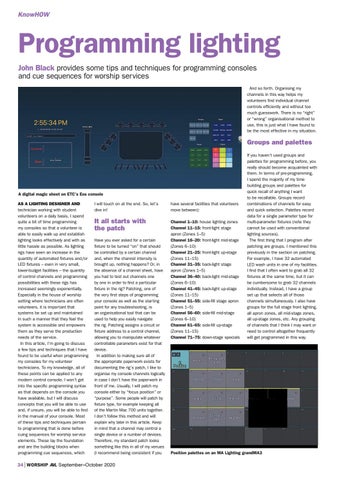KnowHOW
Programming lighting John Black provides some tips and techniques for programming consoles and cue sequences for worship services And so forth. Organising my channels in this way helps my volunteers find individual channel controls efficiently and without too much guesswork. There is no “right” or “wrong” organisational method to use, this is just what I have found to be the most effective in my situation.
Groups and palettes
A digital magic sheet on ETC’s Eos console AS A LIGHTING DESIGNER AND technician working with student volunteers on a daily basis, I spend quite a bit of time programming my consoles so that a volunteer is able to easily walk up and establish lighting looks effectively and with as little hassle as possible. As lighting rigs have seen an increase in the quantity of automated fixtures and/or LED fixtures – even in very small, lower-budget facilities – the quantity of control channels and programming possibilities with these rigs has increased seemingly exponentially. Especially in the house of worship setting where technicians are often volunteers, it is important that systems be set up and maintained in such a manner that they feel the system is accessible and empowers them as they serve the production needs of the service. In this article, I’m going to discuss a few tips and techniques that I have found to be useful when programming my consoles for my volunteer technicians. To my knowledge, all of these points can be applied to any modern control console. I won’t get into the specific programming syntax as that depends on the console you have available, but I will discuss concepts that you will be able to use and, if unsure, you will be able to find in the manual of your console. Most of these tips and techniques pertain to programming that is done before cuing sequences for worship service elements. These lay the foundation and are the building blocks when programming cue sequences, which
I will touch on at the end. So, let’s dive in!
have several facilities that volunteers move between):
It all starts with the patch
Channel 1–10: house lighting zones Channel 11–15: front-light stage apron (Zones 1–5) Channel 16–20: front-light mid-stage (Zones 6–10) Channel 21–25: front-light up-stage (Zones 11–15) Channel 31–35: back-light stage apron (Zones 1–5) Channel 36–40: back-light mid-stage (Zones 6–10) Channel 41–45: back-light up-stage (Zones 11–15) Channel 51–55: side-fill stage apron (Zones 1–5) Channel 56–60: side-fill mid-stage (Zones 6–10) Channel 61–65: side-fill up-stage (Zones 11–15) Channel 71–75: down-stage specials
Have you ever asked for a certain fixture to be turned “on” that should be controlled by a certain channel and, when the channel intensity is brought up, nothing happens? Or, in the absence of a channel sheet, have you had to test out channels one by one in order to find a particular fixture in the rig? Patching, one of the very first steps of programming your console as well as the starting point for any troubleshooting, is an organisational tool that can be used to help you easily navigate the rig. Patching assigns a circuit or fixture address to a control channel, allowing you to manipulate whatever controllable parameters exist for that device. In addition to making sure all of the appropriate paperwork exists for documenting the rig’s patch, I like to organise my console channels logically in case I don’t have the paperwork in front of me. Usually, I will patch my console either by “focus position” or “purpose”. Some people will patch by fixture type, for example keeping all of the Martin Mac 700 units together. I don’t follow this method and will explain why later in this article. Keep in mind that a channel may control a single device or a number of devices. Therefore, my standard patch looks something like this in all of my venues (I recommend being consistent if you
If you haven’t used groups and palettes for programming before, you really should become acquainted with them. In terms of pre-programming, I spend the majority of my time building groups and palettes for quick recall of anything I want to be recallable. Groups record combinations of channels for easy and quick selection. Palettes record data for a single parameter type for multi-parameter fixtures (note they cannot be used with conventional lighting sources). The first thing that I program after patching are groups. I mentioned this previously in the section on patching. For example, I have 32 automated LED wash units in one of my facilities. I find that I often want to grab all 32 fixtures at the same time, but it can be cumbersome to grab 32 channels individually. Instead, I have a group set up that selects all of those channels simultaneously. I also have groups for the full stage front lighting, all apron zones, all mid-stage zones, all up-stage zones, etc. Any grouping of channels that I think I may want or need to control altogether frequently will get programmed in this way.
Position palettes on an MA Lighting grandMA3
34 WORSHIP AVL September–October 2020
WAVL Pg34-35 KnowHow LIGHT.indd 34
24/07/2020 12:42
I m co pa qu Iw co an lib In pr as re re th th pa ha fo
Co gr
I be au al pa co on au (o th ev ch Fo cr
